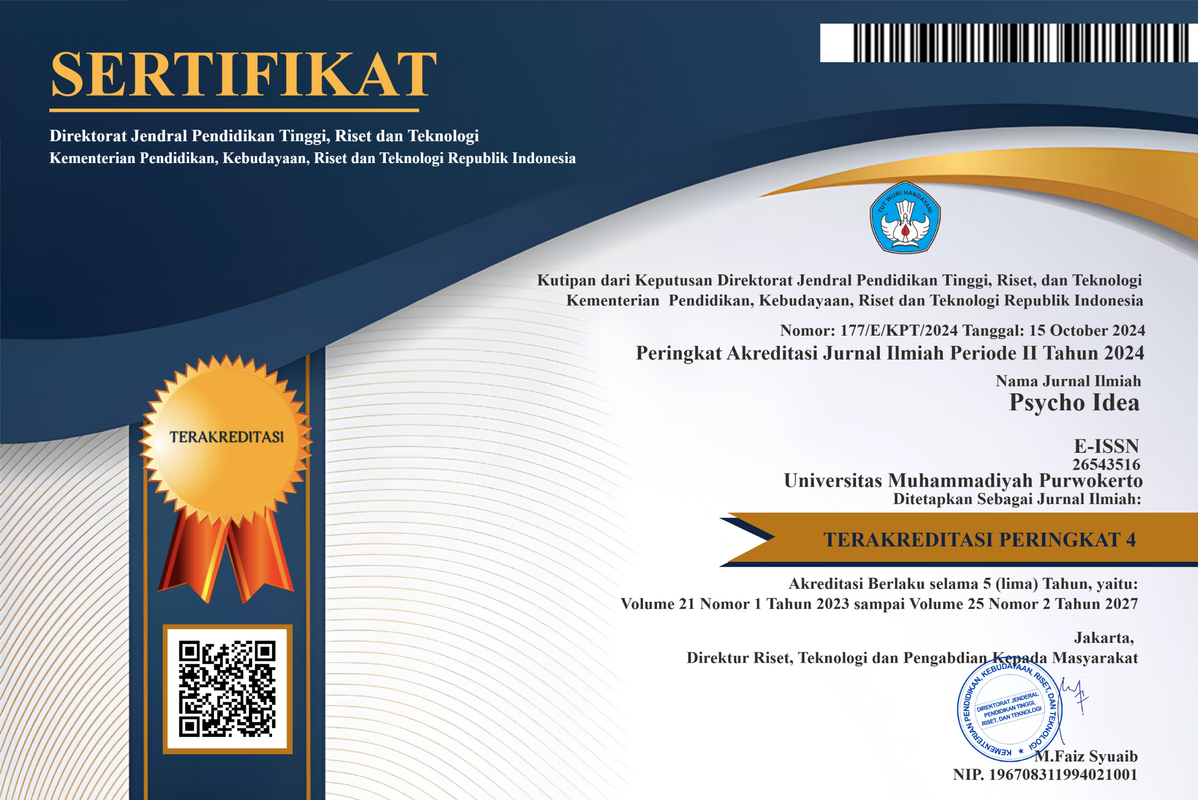STUDI DESKRIPTIF KUANTITATIF TENTANG POLA KELEKATAN REMAJA DENGAN TEMAN SEBAYA PADA PESERTA DIDIK DI SLTP NEGERI 1 AYAH, KEBUMEN
DOI:
https://doi.org/10.30595/psychoidea.v11i2.511Abstract
Penelitian ini bertujuan untuk mengetahui pola kelekatan remaja dengan teman sebaya di SLTP Negeri 1 Ayah. Subjek penelitian ini adalah siswa di SLTP Negeri 1 Ayah, Kebumen. Teknik pengambilan sampel dengan proportional stratified random sampling. Alat pengumpulan data yang digunakan adalah skala pola kelekatan. Uji reliabilitas dari skala Pola Kelekatan Remaja dengan Teman Sebaya dikatakan reliabel karena koefisien reliabilitasnya sebesar 0.887. Validitas pada skala pola kelekatan remaja dengan teman sebaya bergerak dari 0,011 sampai 0,606 dan mengguakan standar kevalidan dari Azwar (2008) yaitu 0,25. Analisis datanya menggunakan deskriptif kuantitatif dengan cara melakukan prosentase dari masing-masing jawaban dari skala yang diisi oleh responden. Hasil penelitian menunjukan bahwa pola kelekatan remaja dengan teman sebaya pada siswa SLTP Negeri 1 Ayah, Kebumen terbentuk antara remaja dengan teman sebaya maka pola kelekatan aman sebanyak 60 siswa dengan prosentase sebesar 54,55%, gaya kelekatan cemas sebanyak 26 siswa dengan prosentase sebesar 23,64%, dan gaya kelekatan menghindar sebanyak 24 siswa dengan prosentase sebesar 21,82%. Kata kunci : pola kelekatan, teman sebayaReferences
Azwar S. (2007). Penyusunan Skala Psikologi. Yogyakarta : Pustaka Pelajar
Bretherton, I. (1992). The Originsof Attachment Theory: John Bowlby and Mary Ainsworth. Development Psychology,28,759-775. (online), (www.Psychology.sunysb.edu/attachment/online/inge_origins.pdf,diakses 04 maret 2011)
Cassidy, Jude, & Shaver, P.R (Eds.). (2002). Handbok of Attachment: Theory, Research, and Clinical Applications, (Online), (http://book.google.co.id, diakses 04 maret 2011)
Conger, J.J. (1991). Adolescence and youth (4th ed). New York: Harper Collins
Desmita. (2005). Psikologi Perkembangan. Bandung : PT. Remaja Rosda Karya.
Hurlock, E.B. (1997). Psikologi Perkembangan, Suatu Pendekatan Sepanjang Rentang Kehidupan. (Alih bahasa: Istiwidayanti.,Soedjarwo.,Sijabar,R.M). Jakarta:Erlangga
Mutadin, Z., (2002). Penyesuaian Diri Remaja. www.e-psikologi.com. Diakses 15 April 2011
Papalia, D. E., Old, S. W., Feldman, & R. D. (2008). Human Development (terjemahan A. K. Anwar). Jakarta: Prenada Media Group.
Santrock, J. W. (2002). Life-Span Development. Jilid 2 (terjemahan Chusairi Achmad dan Damanik Judo). Jakarta: Erlangga.
. (2003). Adolescence Perkembangan Remaja (terjemahan Adelar, S.B., dan Saragih, S). Jakarta: Erlangga
Yessy. (2003). Hubungan Pola Attachment dengan Kemampuan Menjalin Relasi Pertemanan pada Remaja. Jurnal Psikologi, Vol. 12, no. 2, 1-12.
Downloads
Published
Issue
Section
License
Authors published in this journal agree to the following terms:
- The copyright of each article is retained by the author (s) without restrictions
- The journal allows the author(s) to retain publishing rights without restrictions
- The author grants the journal the first publication rights with the work simultaneously licensed under the Creative Commons Attribution License, allowing others to share the work with an acknowledgment of authorship and the initial publication in this journal.
- Authors may enter into separate additional contractual agreements for the non-exclusive distribution of published journal versions of the work (for example, posting them to institutional repositories or publishing them in a book), with acknowledgment of their initial publication in this journal
- Authors are permitted and encouraged to post their work online (For example in the Institutional Repository or on their website) before and during the submission process, as this can lead to productive exchanges, as well as earlier and larger citations of published work
- Articles and all related material published are distributed under a Creative Commons Attribution-4.0 International Public License (CC - BY 4.0).
License
Psycho Idea is licensed under a Creative Commons Attribution- 4.0 International Public License (CC - BY 4.0).
You are free to :
Share — copy and redistribute the material in any medium or format
Adapt — remix, transform, and build upon the material for any purpose, even commercially











